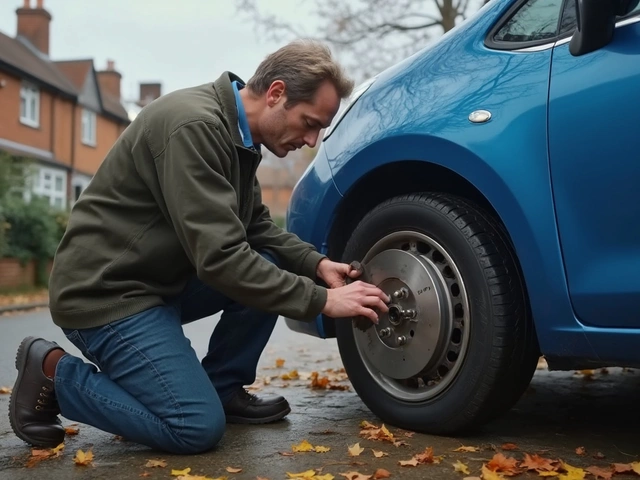Wondering how much time you’ll actually lose replacing a clutch? You’re not alone. Mechanics usually quote anywhere from 3 to 7 labor hours for a clutch replacement, but that’s just an average. Some cars, like compact front-drivers, can be sorted in a couple of hours. Others—think pickup trucks or older sports cars—can eat up almost a day.
What makes one job faster than another? It's not just the make and model. Even a corroded bolt or a rusted exhaust can throw off the whole schedule. If you’re thinking about tackling this as a DIY project, plan for extra time—especially if you’re not familiar with all the sneaky bits hiding under your car. Shops with lifts and fancy tools go way faster than someone on a driveway with a jack and some elbow grease.
- Average Labor Hours for Clutch Replacement
- Factors That Affect Clutch Replacement Time
- Front-Wheel vs Rear-Wheel Drive: Why the Difference Matters
- Professional Shop vs DIY: Time and Hassles
- Money-Saving Tips and Pitfalls to Avoid
- Signs You Might Need to Replace Your Clutch Soon
Average Labor Hours for Clutch Replacement
You’ve probably seen quotes all over the place for how long a clutch replacement takes, but let’s get clear: for most standard cars, expect 3 to 7 hours of shop labor. That’s not just me guessing—major repair guides and popular auto repair databases put the sweet spot right there. For example, on a 2015 Honda Civic, most mechanics will clock around 4 hours for a straight clutch swap, assuming no complications. Something a bit bulkier, like a Ford F-150, could easily stretch to 7 hours if the setup is tight and there’s more to take apart.
Those estimates come from real shop software used by mechanics all over North America. Flat-rate books, like Mitchell or Chilton, are what the pros check when they give you a quote. These numbers are basically averages, and they’re built to cover the job when everything goes as planned. But let’s be real—not every job is textbook. Older cars with rusted bolts, stuck axles, or previous “creative repairs” can add an hour or two without warning.
If you’re driving something rare or exotic—think European sports cars or older Subarus—labor hours can spike. A Porsche Boxster clutch can chew up 10-12 hours, mostly because of tight spaces and weird engineering. Meanwhile, basic compact cars, especially if they’re popular models, tend to fall closer to the low end of the range.
Here’s what most drivers can expect for a typical clutch job:
- Popular front-wheel drive cars: 3-5 hours
- Rear-wheel drive sedans and trucks: 4-7 hours
- Exotic or rare vehicles: 8+ hours—sometimes a lot more
It pays to check your specific model on an auto forum or with the shop before you book anything. Surprises are common, but having a ballpark number keeps you from getting blindsided at the checkout.
Factors That Affect Clutch Replacement Time
The biggest thing that messes with how long a clutch replacement takes is the design of your car. Some cars were built with easy repairs in mind. Others, not so much. For example, a small hatchback might have a clutch you can get to in under three hours, while a big truck or a car with an all-wheel-drive system could double that time.
It’s not just about car size either. The type of drive—front, rear, or all-wheel—matters a lot. Front-wheel-drive cars usually take less time because their transmission and clutch are often more accessible. Rear-wheel and especially all-wheel-drive cars are a whole other story, since more stuff has to come out before you even see the clutch.
Here are some of the real things that can speed up or slow down clutch replacement:
- Make and Model: Some car brands pack things tight under the hood, making the clutch harder to reach.
- Transverse vs. Longitudinal Engine Layout: Transverse engines (sideways) are usually easier to deal with for clutches than longitudinal (front-to-back) setups.
- Drivetrain: All-wheel drive adds extra parts in your way—think axles, transfer cases, and sometimes driveshafts.
- Condition of Fasteners: Rusted or stripped bolts can turn a quick job into a marathon.
- Experience: A first-timer can take twice as long as a seasoned mechanic.
- Tools and Equipment: Shops with lifts and transmission jacks go way faster. Working with hand tools on jack stands slows everything down.
Take a look at how the average labor hours break down for some popular types of vehicles:
| Vehicle Type | Average Labor Hours |
|---|---|
| Small front-wheel-drive car | 3–4 hours |
| Mid-size rear-wheel-drive car | 4–6 hours |
| All-wheel-drive vehicle | 6–8 hours |
| Full-size pickup | 5–7 hours |
Unexpected stuff can also cause delays—like finding out a flywheel is damaged, needing an extra part, or wrestling with a seized bolt. If you’re doing this yourself, always budget a little more time than you think you’ll need. No one likes being stuck on a project way past sunset.
Front-Wheel vs Rear-Wheel Drive: Why the Difference Matters
If you’re trying to guess how long a clutch replacement will tie up your car, you need to know if it’s front-wheel drive (FWD) or rear-wheel drive (RWD). This one detail can change the whole job. FWD cars cram both the engine and transmission across the front of the car, which sounds simple… but it’s actually harder to get at everything. Usually, you’ll need to loosen or remove things like the subframe and even wrestle with the axles. That’s why most shops charge more time for FWD clutch replacements than they do for RWD.
By comparison, RWD setups have their engines up front and drive wheels in the back, with a long driveshaft between. To get to the clutch, you generally just drop the driveshaft and pull back the transmission—plenty of space compared to crawling around a fender while dodging suspension parts. Classic muscle cars and old trucks? Sometimes those are the easiest jobs, even without fancy tools.
Here’s a quick look at average shop labor hours for different setups:
| Drivetrain Type | Average Labor Hours | Notes |
|---|---|---|
| Front-Wheel Drive (FWD) | 5 - 7 | Axles and subframes slow things down |
| Rear-Wheel Drive (RWD) | 3 - 5 | More direct access, fewer parts in the way |
| All-Wheel Drive (AWD) | 6 - 9 | Extra drivetrain bits make it the trickiest |
If you have an AWD setup—think a Subaru or many modern SUVs—expect the clutch job to eat up even more clock. Extra drive axles, transfer cases, and complicated layouts mean more stuff to undo before you get to the actual clutch plate. So if time and money matter, knowing your drivetrain can save you headaches before you even start.
- Tip: Always ask your shop or check the service manual for your car’s estimated labor time. Some newer FWD models are designed better, but many still test a mechanic’s patience.
- If you’re doing this at home, take photos as you go so you remember how everything fits together. There’s a lot more to remove on FWD and AWD cars than you’d think at first glance.

Professional Shop vs DIY: Time and Hassles
If you’re looking to cut costs, doing a clutch replacement yourself might sound like a sweet deal. But here's the thing—what looks like a simple swap on YouTube can drag out way longer in real life. Shops with lifts and power tools often knock out most clutch jobs in 3 to 7 hours. They’ve got experience, specialty tools, and sometimes even access to quicker parts suppliers. Plus, if something goes wrong, it’s their responsibility—not yours.
Take the average home mechanic: changing a clutch at home can eat up a whole Saturday, maybe even the entire weekend. If anything’s rusted or stuck, add more hours. Getting the transmission out and back under the car, especially with just a jack and stands, can get tricky—fast. It’s not just about swapping the parts. You have to deal with stuck bolts, precise alignment, and sometimes unplanned trips to buy a tool you suddenly need.
| Who | Average Labor Hours | Other Factors |
|---|---|---|
| Professional Shop | 3–7 | Lift, experience, warranty, faster |
| DIY | 8–12+ (for first-timers) | Needs tools, patience, time, learning curve |
One big benefit of the shop route is peace of mind. Shops usually offer warranties—not just on parts but also on workmanship. Mess up a driveway job, and you have to fix it yourself. But if the shop does, they have to make it right.
- DIY clutch swaps can save cash—if you have the tools and skill.
- Professional jobs cost more, but you pay for speed, expertise, and less stress.
- Never done it before? Double your time estimate and expect surprises.
Bottom line: if you value your weekend, or you’re worried about getting hung up on tricky steps, the extra cash for a pro might be worth it. But if you love getting your hands dirty and want bragging rights, DIY could still be your thing. Clutch replacement isn’t impossible for a novice, but it’s a job where patience really pays off.
Money-Saving Tips and Pitfalls to Avoid
Not excited about a giant repair bill? You’re definitely not the only one. A full clutch replacement will hit your wallet for anywhere from $700 to $1,500 at most local shops if you drive something pretty common. But don’t let that number scare you—there are ways to shrink the cost if you’re smart.
First, always call around and get a few quotes before agreeing to anything. Labor time can vary by shop—sometimes by a couple of hours. You’d be surprised how much difference that makes on your invoice. If you bring your own clutch kit, some places will knock off a chunk of the markup, though double-check they’re cool with DIY parts.
Watch out for the classic mistake: skipping small worn parts. If you’re having someone swap the clutch, ask them to inspect the flywheel, slave cylinder, and throw-out bearing. These parts are right there and cheap to replace at the same time. If you don’t, you might pay double in labor next time one of them fails.
If you’re doing it in your own garage, here’s what matters most:
- Borrow a transmission jack or proper lift—makes life 10 times easier than wrestling with heavy parts on your chest.
- Take tons of pictures before you tear things apart. Routing cables and hoses the wrong way is a classic newbie headache.
- Don’t cheap out on tools like torque wrenches or good quality sockets. Rounded bolts will cost you serious time and sanity.
- Have all your parts ready so you’re not scrambling to the store mid-job.
Here’s a quick breakdown of where the money goes for a typical mid-size car clutch job:
| Item | Typical Cost (USD) |
|---|---|
| Clutch Kit | $150 - $400 |
| Labor (4-6 Hours) | $400 - $800 |
| Optional Parts (Flywheel, Hydraulics) | $100 - $300 |
Don’t get tempted by cheapest possible kits online, either. Knockoff clutch kits on auction sites often cause more drama later—like weird pedal feel or even early failure. Stick to brands people trust. Check out car forums for real-world reviews from drivers who’ve already put the miles on a given kit before buying.
Bottom line—do your research, plan your time, and don’t skip the details. A little prep work now can save you hundreds, plus hours of hassle the next time you hit the road.
Signs You Might Need to Replace Your Clutch Soon
Clutch trouble usually doesn’t show up out of nowhere. Most drivers start to notice little problems before the clutch totally gives out. Catching these early can save money and a big hassle—nobody wants to be stuck in traffic with a car that won’t budge.
Here’s what to watch out for if you think your clutch might be on its last legs:
- Clutch replacement feels closer when the pedal starts slipping—meaning you press the pedal, but the car accelerates slowly or the engine revs jump up without picking up speed. Slipping is the classic sign your clutch is wearing out.
- Weird noises, like grinding or squealing, when pressing the clutch pedal can mean trouble. Sometimes these noises point to a bad release bearing, but either way, something’s up.
- Hard shifts or feeling like you have to shove the gear stick into place is a big red flag. This isn’t just annoying—it can mean the clutch isn’t disengaging fully.
- Burnt smell, especially after working through stop-and-go traffic, might be your clutch overheating. If it smells like burning toast, don’t ignore it.
- A clutch pedal that feels mushy or sticks to the floor shows something’s failing, usually the master or slave cylinder. Hydraulic parts do wear out, so keep that in mind.
If you’re not sure, here’s a quick table with stats on common clutch life expectancy (for regular drivers, not race car folks):
| Car Type | Typical Clutch Life (Miles) | Main Sign of Trouble |
|---|---|---|
| Compact Car | 70,000–120,000 | Slipping, soft pedal |
| Pickup Truck | 60,000–100,000 | Grinding when shifting |
| Sports Car | 30,000–60,000 | Slipping, burnt smell |
Remember, mileage is just a guideline. How you drive, city versus highway, and towing heavy stuff make a big difference. If you catch any of these signs early, you can plan your clutch repair before it surprises you.




